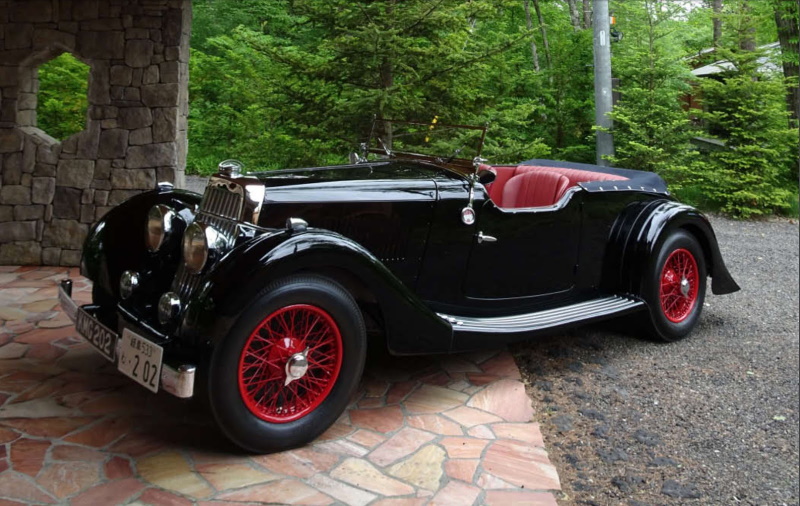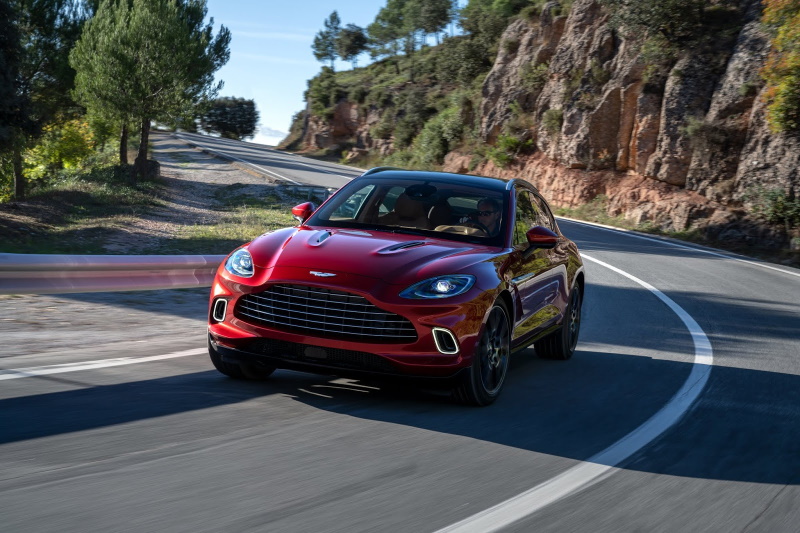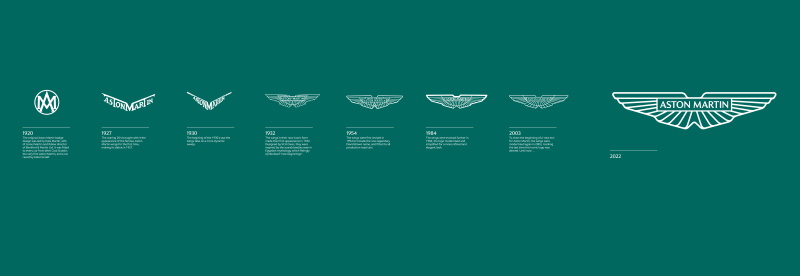by Michael Satterfield - Updated 07/20/2022
Founded in 1913 by Lionel Martin and Robert Bamford, 'Bamford & Martin Limited would get their start selling Singer vehicles from their London dealership and garage where they also serviced GWK and Calthorpe vehicles. Their first car was a modified 1908 Isotta Fraschini fitted with a four-cylinder Coventry-Simplex engine. Martin would race their cars in the Aston Hill Climb about 40 miles northwest of London, where his success gave birth to the name 'Aston Martin' in 1914.
One year later they would open their first works at Henniker Mews in Kensington where the first production Aston Martin would be built in March 1915, however, with the outbreak of World War I, production was halted and the machinery was sold. Lionel joined the Admiralty and Robert the Royal Army Service Corps, where they would both serve until the end of the war.
1914 Aston Martin Coal Scuttle
But despite early racing success by 1925 Bamford & Martin was forced to file for bankruptcy, only to be resurrected in 1926 by a group of investors who formed 'Aston Martin Motors Limited' who moved operations to the former Whitehead Aircraft Limited Hanworth works in Feltham.
Under new leadership, Aston Martin was gaining a reputation for superb engineering and design. The Halford Special would see much success setting several land speed records and taking ten podiums including four 1st place finishes in the 1926-1927 seasons, and in 1928 the company would enter their first car in the 24-Hours of Le Mans.
A-C Bertelli a designer and racing driver and his partner William Renwick, an engineer who had developed a four-cylinder 1.5 Litre overhead camshaft joined Aston Martin in 1926. Bertelli would serve as both the designer and technical director of all Aston Martins built between 1926-1937. Most of Bertelli's designs were two-seat sports cars with bodywork by done by his brother Enrico Bertelli, a few long-chassis four-seaters, dropheads, and sedans were also built under Berelli's direction.
1937 Aston Martin 15/98 Long Chassis Tourer by Bertelli
Postwar the Huddersfield gear and machine tools manufacturer David Brown Limited bought Aston Martin and Lagonda, moving all operations to Newport Pagnell, home to Aston Martin Works to this day. With Lagonda, came their 2.5-liter W.O. Bentley-designed engine that would go on to power the "DB" series of cars. In 1950 the all-new DB2 Le Mans prototype was announced, a car that is the foundation for many of the iconic design cues that Aston Martin is still known for today.
1956 Aston Martin DBR1
and Jim Clark all piloted the DBR1.
Coming off of the success of 1959, Aston Martin solidified its place as a true manufacturer of exotic sports cars and began to see more commercial success. The 1964 James Bond film 'Goldfinger' would catapult Aston Martin into the limelight of an international audience, with the silver DB5 becoming one of the most iconic movie cars of all time. The DB5 would be produced until 1970, with the more modern DBS being built from 1967-1972, the DBS V8 from 1969-1972, and just seven DBS Loganda sedans built before finical troubles would again strike.
1963 Aston Martin DB5
In 1975 a new group of investors leads by businessman Peter Sprague from Toronto purchased the fledgling company and pledged to turn the company around. Six months later the new company 'Aston Martin Lagonda' opened with 100 employees. The new range included the 1977 V8 Vantage, the convertible Volante in 1978, and the futuristic new Lagonda sedan, based on the V8 model "the fastest four-door in the world" at the time.
1982 Aston Martin Lagonda
Aston Martin Bulldog Concept
Peter Sprague didn't just want Aston Martin Lagonda to produce the best sedan in the world, he also wanted to build Aston's first true supercar, the project was code-named DP K901, better known as the Bulldog. The DP K901 was meant to showcase the capabilities of Aston's new engineering facility in Newport Pagnell and be the fastest production car in the world. Unveiled in March 1980 the Bulldog featured gull-wing doors, center-mounted hideaway headlamps, and similar electronic gages and switches as seen in the Lagonda. Aston had planned on building 25 of these, but only the original prototype ever saw the light of day.
By 1984 Aston Martin had had a few new investors come and go, and even though the year marked the production of the brand's 10,00th car, the company still had to lay off nearly 1/3rd of its workforce. In 1986 the company revived its relationship with Italian coachbuilder Zagato resulting in the Aston Martin V8 Zagato, built between 1986-1990.
1987 would see James Bond return to an Aston Martin in 'The Living Daylights' starring Timothy Dalton in the V8 Vantage. But as cool as the original V8 Vantage was the car was already ten-years-old, and new funding and designs were needed, in 1988 Ford Motor Company would become that source to purchase Aston Martin adding it to its portfolio of brands which already included British carmaker Jaguar called the Premier Automotive Group.
Under Ford, the new 1989 Virage and Vantage brought Aston into the modern era with several variants being produced including the Volante and Le Mans. In 1993 Aston announced that the DB series would be returning to production with the all-new DB7 sharing much of its chassis and drivetrain with its new sibling Jaguar. The former Jaguar factory in Bloxham, Oxfordshire would become home to the DB7 production, while the still largely handbuilt Virage variants would be built in Newport Pagnell. The DB7 was a hit with over 7,000 of them being produced, a far cry from the days of producing just 30 cars year.
Under Ford, Aston Martin would produce some of its most enduring sports cars, the DB9, Vantage, and the Aston Martin V12 Vanquish. In 2002, everyone's favorite international spy, 007, would be behind the wheel of a modern Aston Martin again. The Aston Martin V12 Vanquish from 'Die Another Day' reconnected the brand to the films and again created a new generation of fans.
In December 2003, Aston Martin announced it would return to motor racing, with a dedicated division called Aston Martin Racing, which would be partnering with Prodrive to develop the DB9R. In 2005 the DB9R made its debut competing in GT Sports Car Racing, including a return to the 24 Hours of Le Mans.
In 2006, Ford began selling off its Premier Automotive Group, divesting itself of the Volvo, Jaguar, Land Rover, and Aston Martin brands. Prodrive chairman David Richards pooled a team of international investors to purchase Aston Martin for $848m, with Ford keeping a $70m stake.
The first Aston Martin Rapide was produced at the Magna Steyr factory in Graz, Austria in 2010, Rapide production would return to the UK in 2012, bringing all manufacturing in-house once again. But 2012 would be another year that would have Aston Martin looking for new investors, which they found in the form of a private equity fund, Investindurial, who purchased 37.5% of Aston Martin As sales continued to decline through 2014 Aston Martin sought new customers in emerging markets. A strategy was put in place by former Nissan CEO Andy Palmer who took the helm of Aston Martin in 2014.
2016 saw the first fruits of a technology partnership Aston Martin signed with Mercedes Benz, with the new DB11 featuring a Mercedes-AMG engine and Mercedes electronics for the entertainment, navigation, and other systems. The 2019 V8 Vantage, unveiled in late 2017, employed Mercedes twin-turbo V8 and electronic and infotainment systems.
1987 would see James Bond return to an Aston Martin in 'The Living Daylights' starring Timothy Dalton in the V8 Vantage. But as cool as the original V8 Vantage was the car was already ten-years-old, and new funding and designs were needed, in 1988 Ford Motor Company would become that source to purchase Aston Martin adding it to its portfolio of brands which already included British carmaker Jaguar called the Premier Automotive Group.
1997 V8 Vantage V550
Under Ford, Aston Martin would produce some of its most enduring sports cars, the DB9, Vantage, and the Aston Martin V12 Vanquish. In 2002, everyone's favorite international spy, 007, would be behind the wheel of a modern Aston Martin again. The Aston Martin V12 Vanquish from 'Die Another Day' reconnected the brand to the films and again created a new generation of fans.
Aston Martin Racing V12 Vantage GT3
In 2006, Ford began selling off its Premier Automotive Group, divesting itself of the Volvo, Jaguar, Land Rover, and Aston Martin brands. Prodrive chairman David Richards pooled a team of international investors to purchase Aston Martin for $848m, with Ford keeping a $70m stake.
The first Aston Martin Rapide was produced at the Magna Steyr factory in Graz, Austria in 2010, Rapide production would return to the UK in 2012, bringing all manufacturing in-house once again. But 2012 would be another year that would have Aston Martin looking for new investors, which they found in the form of a private equity fund, Investindurial, who purchased 37.5% of Aston Martin As sales continued to decline through 2014 Aston Martin sought new customers in emerging markets. A strategy was put in place by former Nissan CEO Andy Palmer who took the helm of Aston Martin in 2014.
DBS Superleggera
Aston Martin Valkyrie
In 2016 Aston Martin also released the AM-RB 001 concept, which would go on to become the 2017 Aston Martin Valkyrie hybrid supercar in collaboration with Red Bull Racing. The name AM-RB 001 literally means Aston Martin and Red Bull with 001 being the first project they collaborated on. The Name Valkyrie comes from the mythological Norse guides who lead soldiers to Valhalla. In 2019 a spider variant was announced, with just 85 spiders to be produced starting in 2023. Powered by a 6.5-liter naturally-aspirated V12 engine tuned by Cosworth, which produces around 1,000 hp paired to a bespoke electric motor provided by Integral Powertrain Ltd.
Valkyrie AMR Pro
A track-only version of the Valkyrie was introduced at the 2018 Geneva Motor Show, production was limited to just 25 with the first production races being delivered in 2022. Dubbed the Valkyrie AMR Pro, the stripped-down racer gets aggressive aero, F1-style carbon brakes, and 18-inch wheels.
Aston Martin CEO, Andy Palmer, has a plan to double sales over the next few years thanks to new products and a strong financial position that has taken the company from in the red, to profitable. In August 2018, Aston has announced it is ready for a long-rumored IPO, following in the footsteps of rival Ferrari.
In late 2018 Aston Martin marked another milestone, by launching the Aston Martin DBX the brand's first Crossover/SUV. The DBX would be unveiled in China in November 2019, as a 2020 model, the first-ever Aston SUV will start at $192,086. Powered by the 4.0-liter twin-turbo Mercedes-AMG V8 that produces 542 horsepower and 516 lb-ft of torque. A nine-speed automatic transmission also supplied by Mercedes is the only option. Aston claims a top speed of 181 mph with a zero-to-60-mph time of 4.3 seconds.
Aston Martin CEO, Andy Palmer, has a plan to double sales over the next few years thanks to new products and a strong financial position that has taken the company from in the red, to profitable. In August 2018, Aston has announced it is ready for a long-rumored IPO, following in the footsteps of rival Ferrari.
Aston Martin's first SUV the DBX
In late 2018 Aston Martin marked another milestone, by launching the Aston Martin DBX the brand's first Crossover/SUV. The DBX would be unveiled in China in November 2019, as a 2020 model, the first-ever Aston SUV will start at $192,086. Powered by the 4.0-liter twin-turbo Mercedes-AMG V8 that produces 542 horsepower and 516 lb-ft of torque. A nine-speed automatic transmission also supplied by Mercedes is the only option. Aston claims a top speed of 181 mph with a zero-to-60-mph time of 4.3 seconds.
Aston Martin DBX Production Model
Between 2016 and 2020 Aston Martin served as a sponsor for Red Bull Racing, marking the marque's first return to Formula 1 since 1960. The team's early efforts in Formula 1 were disappointing and the factory shifted focus back to sports car racing. Aston's partnership with Red Bull Racing netted solid podium finishes, but no championships. In 2020, Racing Point F1 Team owner Lawrence Stroll bought a 16.7 percent stake in Aston Martin, and Racing Point was rebranded as Aston Martin F1 for the 2021 season. The Aston Martin AMR21 was unveiled in March 2021, becoming Aston's first Formula 1 car in 61 years.
Aston Martin AMR21 Formula 1 Car
In July 2022, Aston Martin unveiled the first update to the brand since 2003 and only the eighth time in Aston Martin’s 109-year history that it has been significantly adjusted. According to the press release this updated logo celebrates the company’s position as makers of the most exquisitely addictive performance cars and is centered on its new brand motto; Intensity. Driven.





















_websize.jpg)









